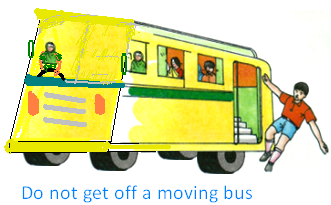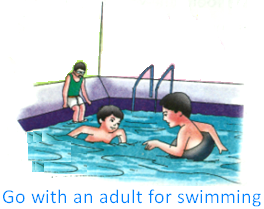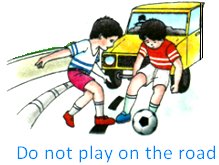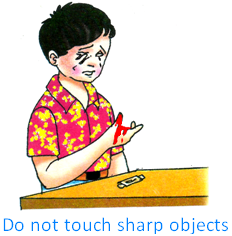Keeping Safe
Keeping safe can save us from injury. Accidents can happen anytime and anywhere. If we are not careful, we can hurt ourselves. Keep safety rules in our mind to keep ourselves safe.
Questions and answers on safety rules and first aid we need to obey on the road, inside a vehicle, in the swimming pool, in the playground, at home and when we get hurt.
1. What are the important safety rules we need to follow on the road?
The important safety rules we need to follow on the road are:
(i) walk on the footpath.
(ii) cross the road only at the zebra crossing.
(iii) cross the road when the traffic light is green for us.
(iv) do not cross the road when the traffic light is red for us.
(v) look at both sides before crossing the road.
(vi) do not run on the road.
2. What are the
important safety rules we need to follow in the bus or vehicles?
The important safety rules we need to follow in the bus or vehicles are:
(i) do not get in or get off a moving bus.
(ii) do not stick your head or hand out of the bus you are in.
(iii) do not shout and scream in the bus.
(iv) standing in a queue to board a bus is a good habit.
(v) do not disturb the driver while he drives the bus.
(vi) never open the door of a moving vehicle.
3. What are the important safety rules we need to follow in the swimming pool?
The important safety rules we need to follow in the swimming pool are:
(i) go with an adult to the pool. Do not go alone.
(ii) do not go to the deep side of the pool.
(iii) if we do not know how to swim, use swimming tubes, floaters or arm-bands for swimming.
(iv) do not eat while swimming
(v) do not run around the pool.
(vi) do not push or pull each other into to the pool.
4. What are the important safety rules we need to follow in the playground?
The important safety rules we need to follow in the playground are:
(i) follow rules while playing the game.
(ii) we need to wait for our turn on swings. Do not stand in front of swings.
(iii) play in a safe place like a park or a playground. Do not play on the road.
5. What are the important safety rules we need to follow at home?
The important safety rules we need to follow at home are:
(i) we need to keep our toys and books and other things at proper places.
(ii) do not touch electric wires, matchsticks or sharp objects like knives, pins and blades. These can hurt us.
(iii) stay away from plug points and sockets.
(iv) do not play with fire.
(v) never tease pets or animals.
(vi) never taste medicines. They can be poisonous.
6. What are the important safety rules we need to follow if we get hurt?
The important safety rules we need to follow if we get hurt are:
(i) for keeping safe we need to keep calm. Don’t feel scared or shout.
(ii) we need to quickly inform an elder around us, they will help us.
(iii) visit a doctor if required.
Note:
For keeping safe we need to follow the measures taken to stay away from harm.
From Keeping Safe to HOME PAGE
Recent Articles
-
What Is Plasma? | Blood Plasma | Proteins | Nutrients | Cholesterol
Nov 07, 25 10:29 AM
Blood is a mobile fluid which is a connective tissue and is derived from the mesoderm like cell any other connective tissue. Colour of blood is reddish and that flows inside the blood vessels by means… -
Disorders of Respiratory System | Tuberculosis | Pleurisy | Emphysema
Oct 28, 25 11:39 PM
Tuberculosis is very common disease and is caused by a type of bacteria called Mycobacterium tuberculosis. This disease causes different trouble in the respiration and infection of several parts of th… -
Regulation of Respiration | Respiratory Centres | Inspiratory Area |
Oct 14, 25 12:13 AM
Respiratory Centre is the area that controls the rate of respiration and it is observed to be located in medulla oblongata and pons. Respiratory Centre has the following will dispersed components like… -
Explain Transport of Gases | External Respiration | Tissue Respiration
Oct 09, 25 11:35 PM
In humans gaseous exchange is completed in the following ways the steps are - External Respiration or Breathing - Breathing in false taking in of Oxygen and giving out of carbon dioxide in the body. M… -
Kind and Number of Teeth | Location of Teeth in Mouth | Care of Teeth
Sep 11, 25 12:52 AM
Kind and Number of Teeth










New! Comments
Have your say about what you just read! Leave me a comment in the box below.